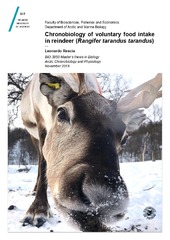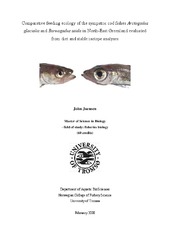Browsing Mastergradsoppgaver i biologi by Title
Now showing items 41-60 of 362
-
Cardiotoxic Effects from the Water-Soluble Fraction of Crude Oil on an Arctic Keystone Species – Polar Cod (Boreogadus saida)
(Master thesis; Mastergradsoppgave, 2019-05-23)Abstract The Arctic ecosystems and its species are under increased anthropogenic pressure from both climate change and industrial activities. Of special interest is pollution from petrogenic substances, and in particular accidental oil spills, that pose a risk to arctic marine organisms. An oil spill in the Arctic may see crude oil encapsulated into the sea ice and over time leaching to surface ... -
Cetacean presence on the northern Mid Atlantic Ridge revealed through passive acoustic monitoring
(Master thesis; Mastergradsoppgave, 2022-09-16)Cetaceans are known to utilise the Mid-Atlantic Ridge, a key topographical feature in the Atlantic Ocean, for migratory and feeding purposes. Passive acoustic monitoring was used over a one-year period (2007/2008) to identify cetacean vocalisations that occurred on a location near the Charlie Gibbs Fracture Zone. Using species-specific vocalisations that have previously been documented in the North ... -
The challenge of identifying and conserving valuable ecosystems close to human settlements in a northern area. An approach based on field- and satellite data.
(Master thesis; Mastergradsoppgave, 2007-08)The rich broadleaved forests of North Norway have high species diversity. Mappings of biodiversity have been undertaken in the two municipalities Målselv and Bardu, but these mappings are far from exhaustive. This study examines classification methods for mapping rich broadleaved forests with the use of Landsat ETM+ images, and with vegetation indices as ancillary data. Three classifications were ... -
Change in sugar levels and related gene expression during bilberry fruit development and ripening
(Master thesis; Mastergradsoppgave, 2020-06-15)Vaccinium myrtillus L., commonly known as European blueberry or bilberry, has been used as food and medicine since ancient times. Bilberries are highly valued in European and Asian markets. Sugar accumulation is responsible for the sweet taste of fruit, which is one of the main determinants of fruit quality. However, sugar metabolism in bilberry has not been studied before. This study was aimed to ... -
Changes in environment cause dietary shifts in the Svalbard Arctic fox: A stable isotope study
(Master thesis; Mastergradsoppgave, 2022-02-15)In this thesis, shift in diet of Arctic foxes on Svalbard over a long time frame was analyzed. The Svalbard Arctic fox is a generalist who links the terrestrial and marine ecosystems. The objectives were 1) investigate whether there are spatial and temporal trends in Arctic fox diet on Svalbard, 2) determine how important the changes in the environmental variables are for dietary shifts of the Arctic ... -
Changes in fat metabolism in the seasonal body mass cycle of captive Svalbard rock ptarmigan (Lagopus muta hyperborea)
(Master thesis; Mastergradsoppgave, 2021-05-12)The Svalbard ptarmigan exhibits profound seasonal variations in body mass. The deposition of fat in the fall is an adaptation that allows the ptarmigan to survive periods of food shortages during the Arctic winter. In this study, previously unexplored molecular aspects of this well- established body mass cycle were investigated. Captive Svalbard ptarmigan fed ad libitum and kept under short photoperiod ... -
Changes in Survival with Age in Three Populations of a Long-lived Seabird, the Atlantic Puffin Fratercula arctica
(Master thesis; Mastergradsoppgave, 2021-05-18)Actuarial senescence is the irreversible decline of survival with increasing age. This phenomenon varies widely between taxa and species along the slow-fast continuum. However, inter-populational senescence differences have been less investigated, especially in the avian order. Here, I compared senescence rate between three contrasting populations of the Atlantic puffin (Fratercula arctica), and ... -
Changes in the distribution of marine invertebrates in a warming Barents Sea over the last century
(Master thesis; Mastergradsoppgave, 2023-05-14)The Barents Sea is a shelf sea in the European Arctic and is influenced by the North Atlantic Current and the Arctic Ocean. The North Atlantic Current is composed of warmer, saline waters compared to the cold, fresher waters from the Arctic Ocean. Over the last century, the Barents Sea mean temperature has increased by 1.5°C above a depth of 60m and by 0.5-0.8°C below 60m. This warming is ... -
Characterization of Cuzd1 expression and development of in vivo CRISPR technology in Atlantic salmon (Salmo salar L.)
(Master thesis; Mastergradsoppgave, 2023-05-12)The Atlantic salmon (Salmo salar L.) is a commercially important species that exhibits an anadromous life cycle involving migratory movements between freshwater and marine environments. Understanding the fundamental biology of the Atlantic salmon, particularly during key life history transitions such as smoltification, is therefore of great importance. In light of modern biotechnology and the completed ... -
Characterization of the biological clock in Svalbard ptarmigan (Lagopus muta hyperborea)
(Master thesis; Mastergradsoppgave, 2021-05-18)Svalbard ptarmigan (Lagopus muta hyperborea), permanent inhabitants of the High Arctic, lose daily behavioral rhythmicity during polar day and night, and rhythms in core body temperature (Tb) weaken after prolonged exposure to constant photic conditions. A weak circadian system has been suggested in Svalbard ptarmigan, however, the molecular clockwork in Svalbard ptarmigan has not been investigated ... -
Characterization of the circadian clock in Hooded Seals (Cystophora Cristata) and its interaction with mitochondrial metabolism A multi-tissue comparison and cell culture approach
(Master thesis; Mastergradsoppgave, 2021-06-02)Circadian rhythms regulate living organisms over a 24h period. From daily activity to cellular function. The polar regions are subject to different photoperiods across the year, which impact the environmental conditions on a seasonal and daily basis. Evidence of crosstalk between circadian core clock genes and hypoxia with genes involved the mitochondrial dynamics, as well as oxygen sensing, provide ... -
Characterizing movement and searching behavior of humpback whales at the North-Norwegian coast
(Master thesis; Mastergradsoppgave, 2022-05-16)Studying movement patterns of individual animals over time can give insight into how they interact with the environment and optimize their foraging strategies. Humpback whales (Megaptera novaeangliae) undertake long seasonal migrations between feeding areas in polar regions during summer/early winter and breeding areas in more tropical areas during late winter/spring. The Norwegian Sea is a part of ... -
Chronobiology of voluntary food intake in reindeer (Rangifer tarandus tarandus)
(Master thesis; Mastergradsoppgave, 2018-11-15)In all organisms, biological rhythms arise from the interaction between endogenous clocks and a rhythmic environment. The timing of sunrise and sunset synchronize internal timing processes and inform the organism not only of the time of day, but also of the time of year. For animals living in polar regions biological timekeeping represents a challenge, given that the sun does not rise during the ... -
Circadian disruption by light and its effect on the immune function of the Atlantic salmon (Salmo salar)
(Master thesis; Mastergradsoppgave, 2022-05-16)The Atlantic salmon (Salmo salar) is an anadromous salmonid that begins its life cycle in freshwater streams then, develops, in a process known as smoltification, into a marine-adapted fish prior to its migration to the sea. Smoltification is a photoperiod regulated process which involves extensive change in the salmons’ physiology. In recent years smoltification procedures in aquaculture has been ... -
Circannual rhythms in Arctic charr (Salvelinus alpinus)
(Master thesis; Mastergradsoppgave, 2023-05-15)The Arctic charr (Salvelinus alpinus) is a true arctic species and is considered to be the northernmost freshwater fish. Since this species is being known for its great variability in size, phenotype, colour, ecology and history, some of them are landlocked (which stay in freshwater all their life) and others are anadromous (they undertake summer migrations to sea and then they come back to ... -
Climate-induced range expansions of marine fauna into the Arctic – what is the most likely colonisation route?
(Master thesis; Mastergradsoppgave, 2018-05-14)As a result of climate change, the Arctic faunas of the Northeast Atlantic have begun to shift in an Atlantic direction. One system exposed to such a change is the Northeast Greenland (NEG) Shelf. However, the colonisation route taken by boreal fauna to the NEG shelf is unknown. This knowledge is essential to predict to what extent boreal fauna will dominate Arctic habitats, and alter ecosystems in ... -
Comparative effects of two temperatures (0 & 3 °C) on Polar cod embryonic and larval development
(Master thesis; Mastergradsoppgave, 2019-11-14)Polar cod (Boreogadus saida) are particularly vulnerable to climate change. Increasing our knowledge of polar cod development will help improve our understanding of the impact of climate change and the impacts this might have on the population. This study aimed at characterizing the development of Polar cod from fertilisation to 86 days post fertilisation (dpf) at two temperatures within their ... -
Comparative feeding ecology of the sympatric cod fishes Arctogadus glacialis and Boreogadus saida in North East Greenland evaluated from diet and stable isotope analyses
(Master thesis; Mastergradsoppgave, 2008-02-15)The fish fauna was investigated in autumn 2003 during the TUNU-I Expedition to NE Greenland fjords. Two gadoids Arctogadus glacialis and Boreogadus saida were abundant in many trawl hauls. In this study, the stomach contents and the stable isotope composition were determined in 60 Arctogadus glacialis and 50 Boreogadus saida from Tyrolerfjord and Dove Bugt. The diets were examined by Stomach Contents ... -
Comparing seed carrier transfer ratios for start-up of moving bed biofilter reactors in recirculating aquaculture systems (RAS)
(Master thesis; Mastergradsoppgave, 2023-06-05)Optimizing and documenting use of inoculation and seeding ratios for RAS start-up. -
Comparison of eyfluke (Diplostomum spp.) infections of polymorphic whitefish (Coregonus lavaretus L.) populations in two sub-Arctic Norwegian lakes
(Master thesis; Mastergradsoppgave, 2018-08-15)Abstract Parasites might be small, but they are very important elements in the ecosystems. Parasites may have a strong negative influence on their host, and some species might even manipulate their hosts. Parasites commonly have complex life cycles and may use multiple different hosts. This study has been conducted in two sub-arctic lakes in Northern Norway with polymorphic whitefish populations. ...


 English
English norsk
norsk


















